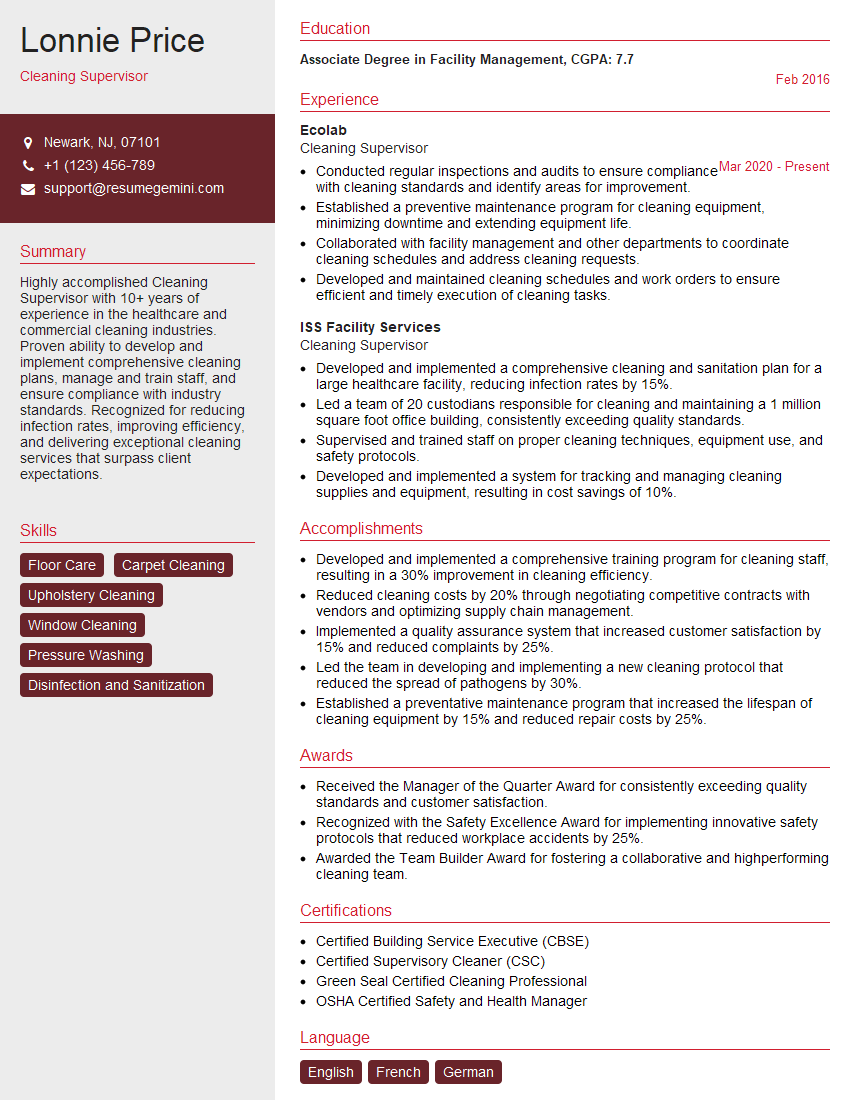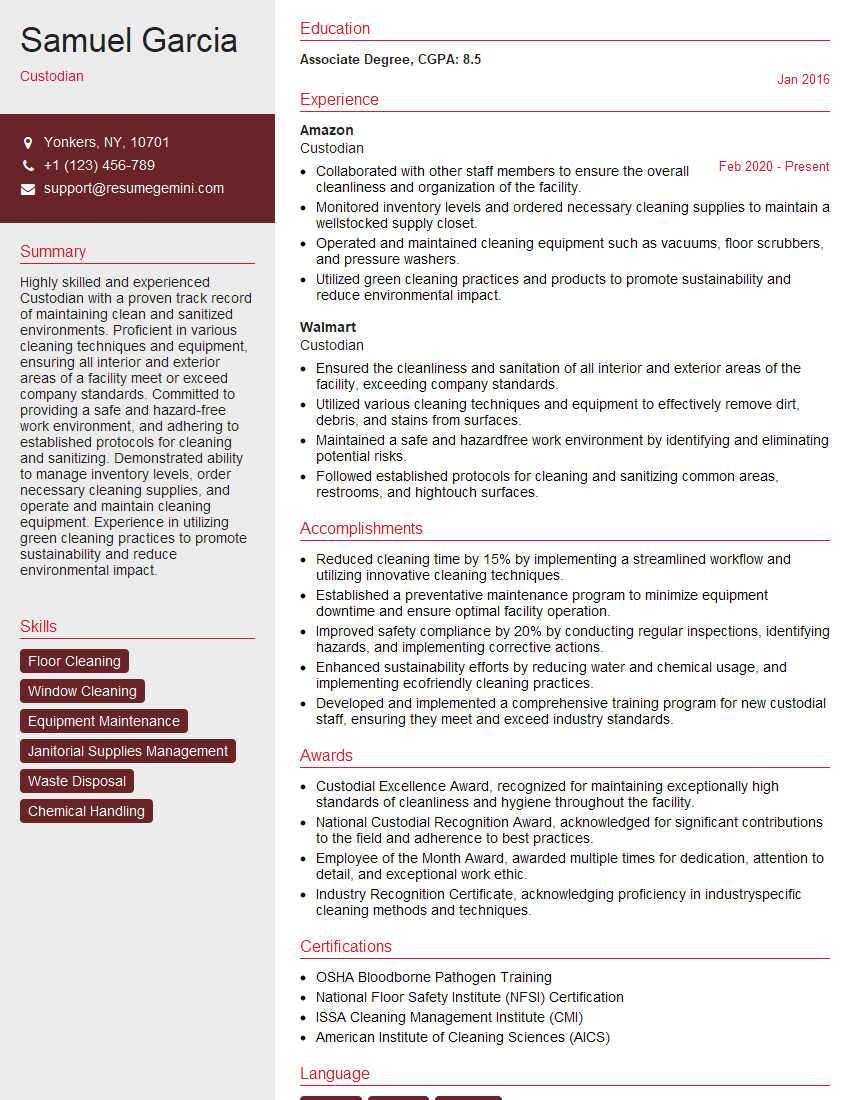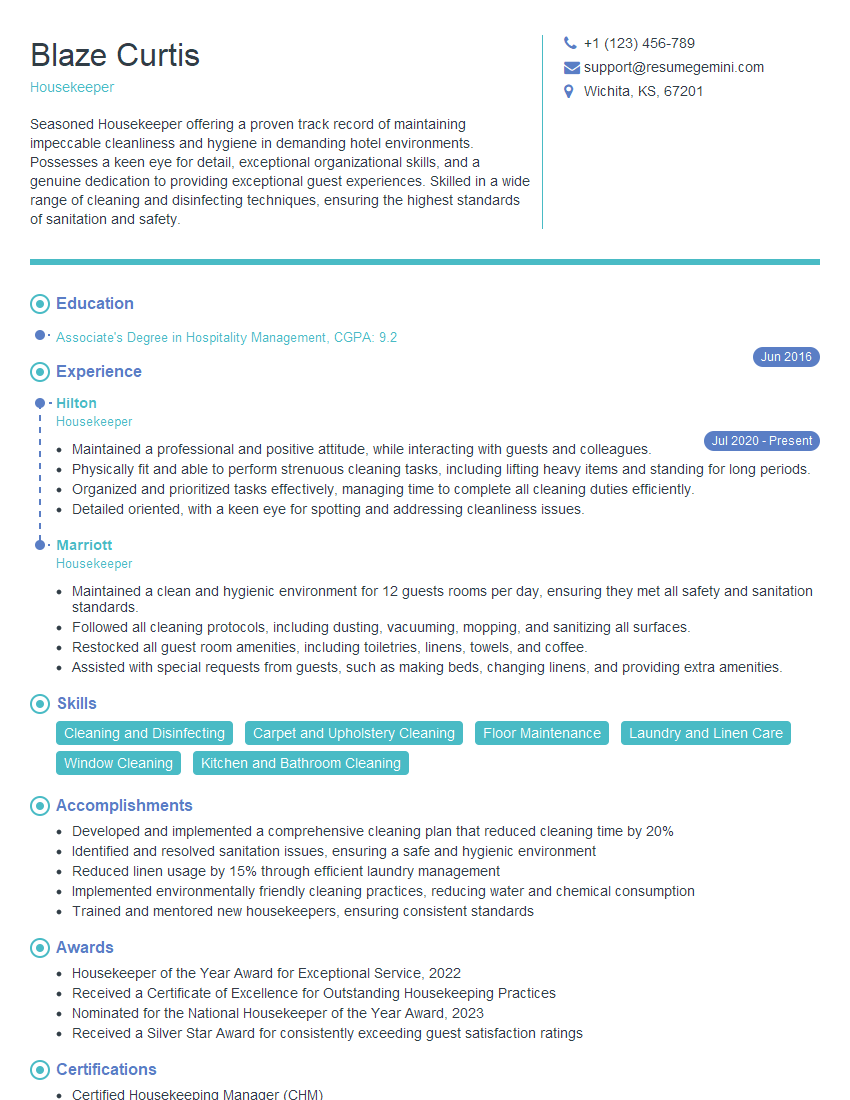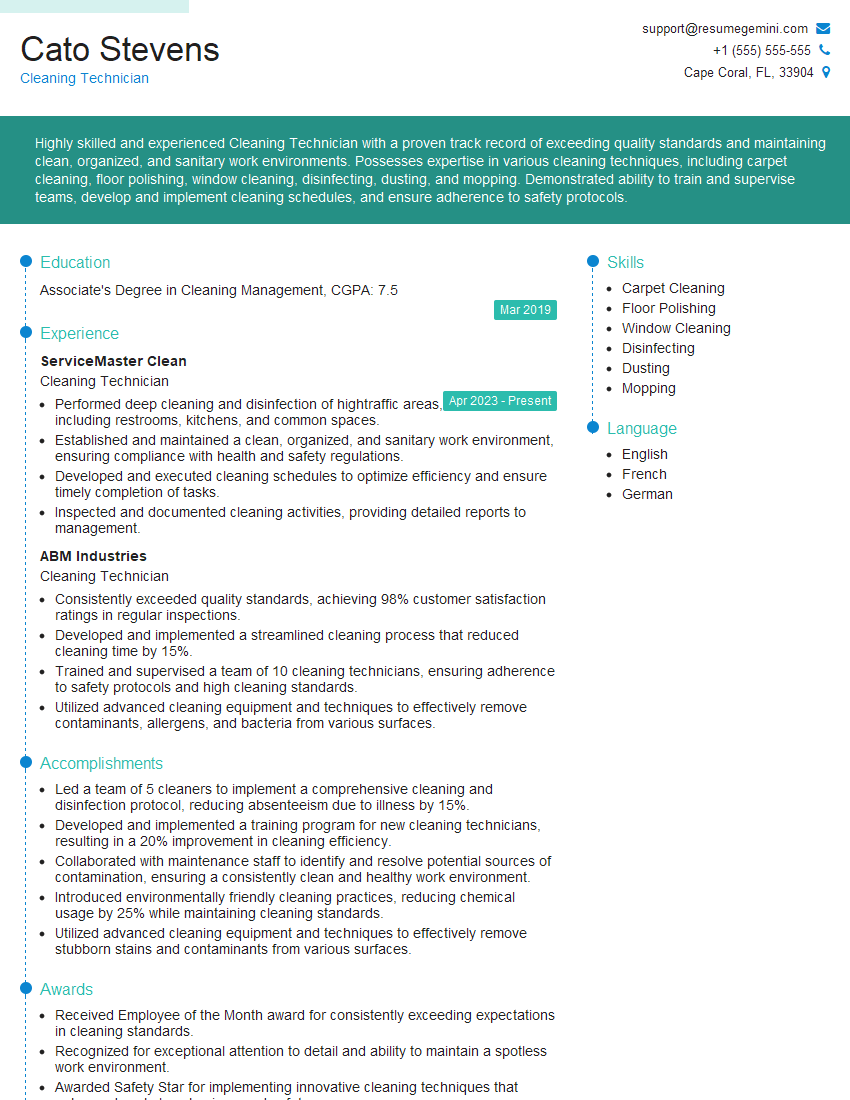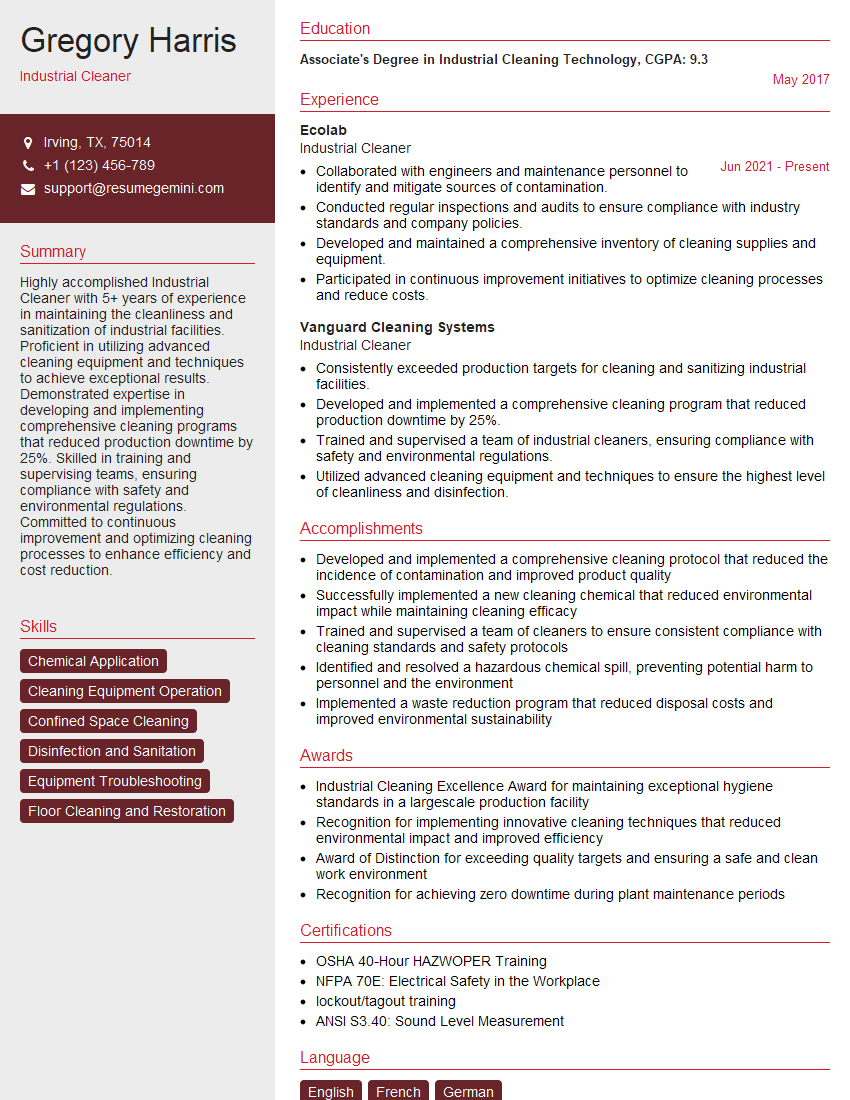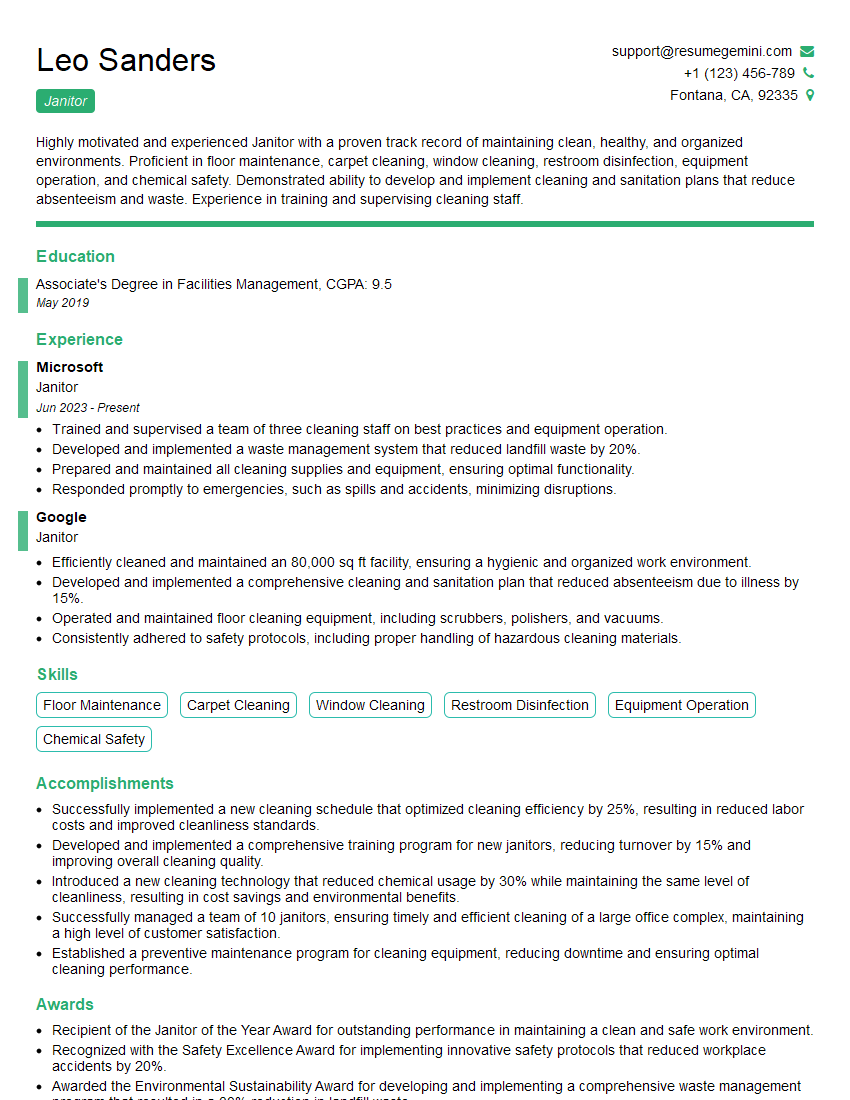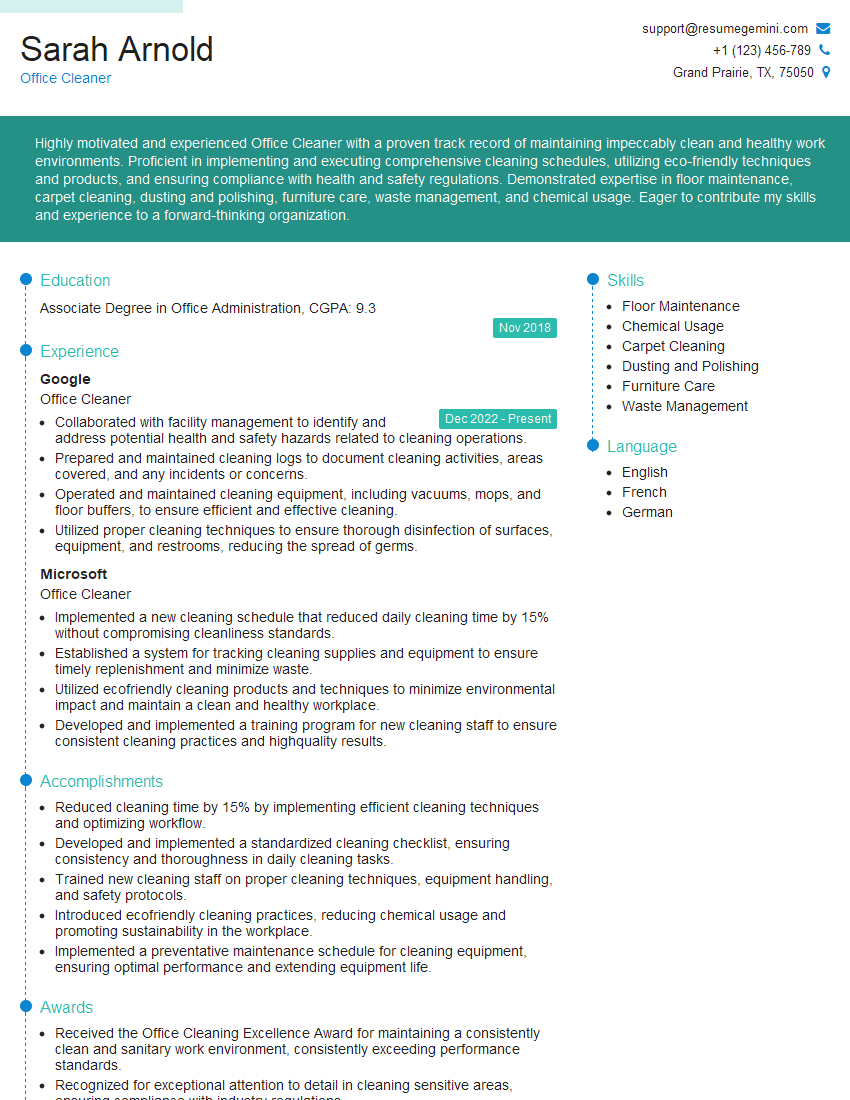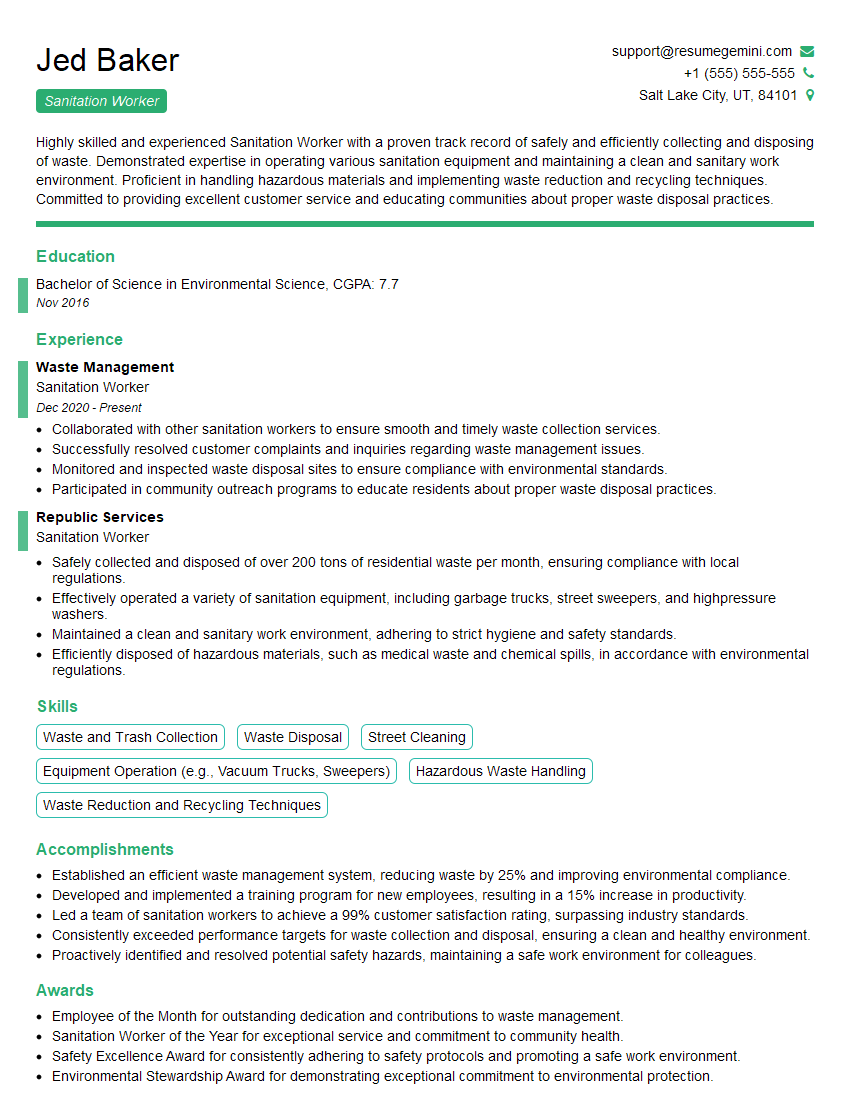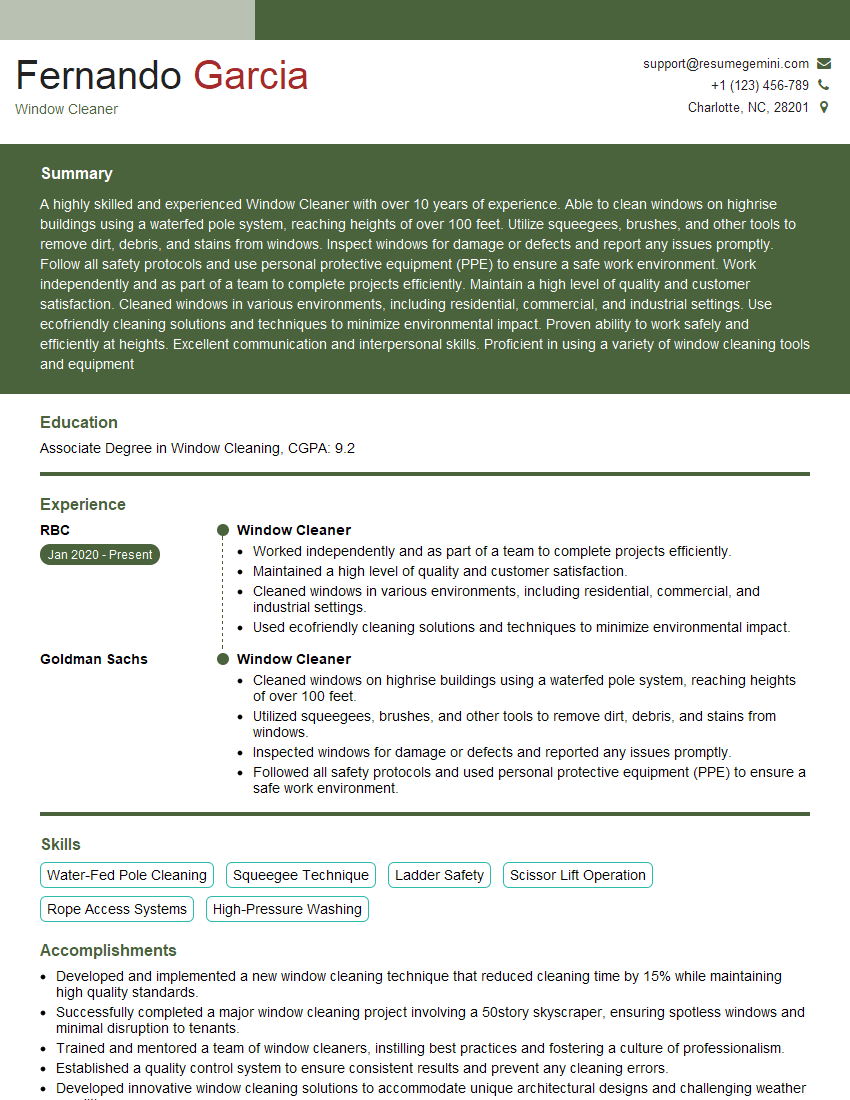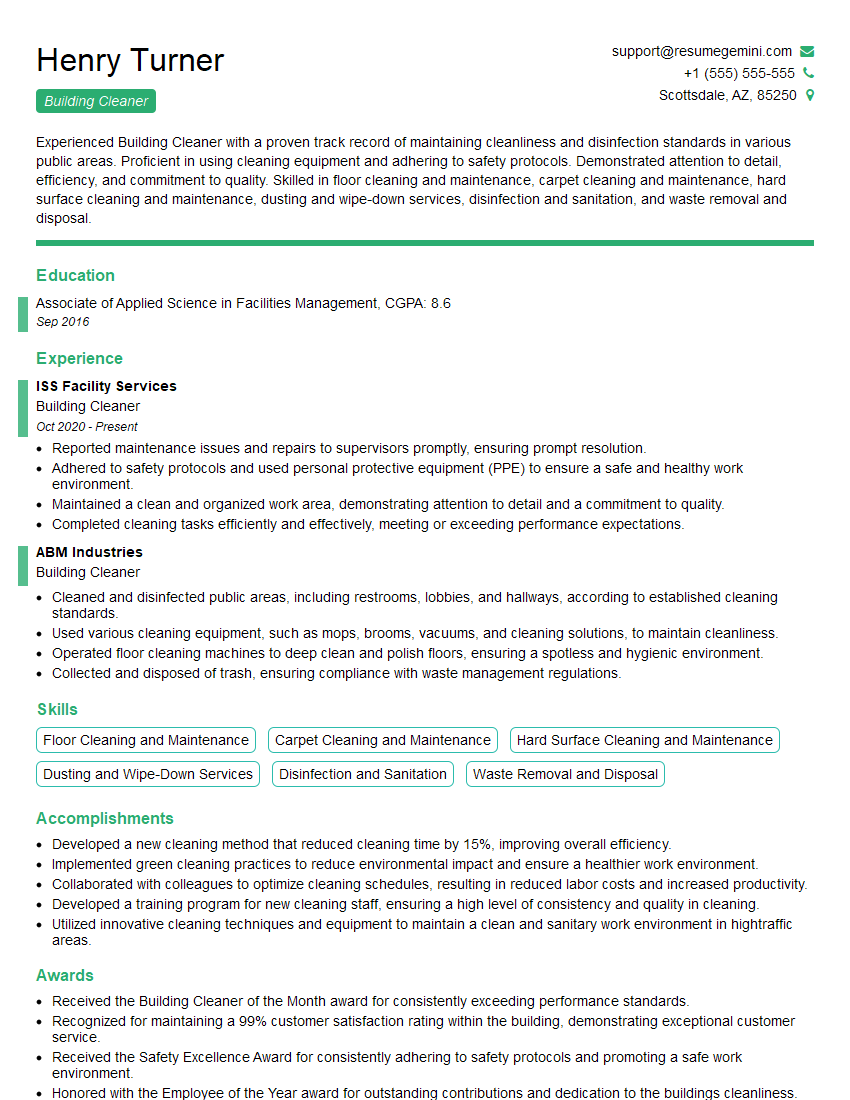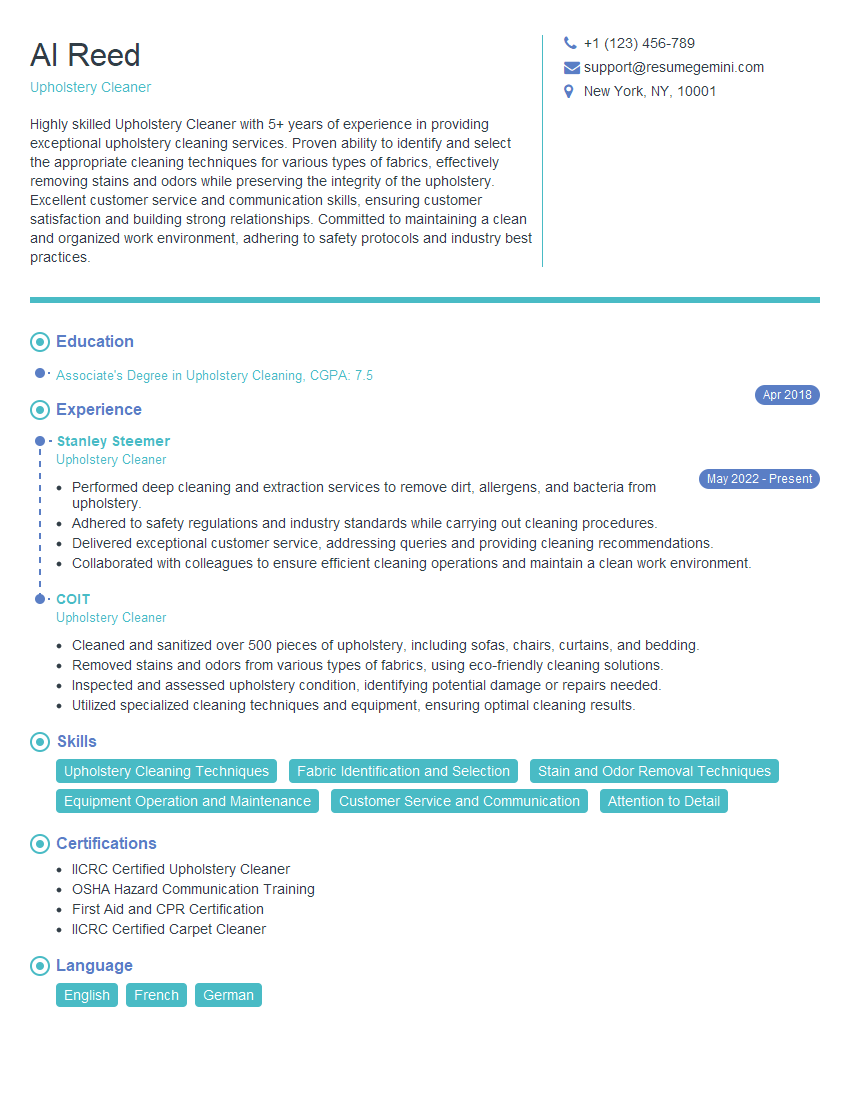Unlock your full potential by mastering the most common Manual Cleaning interview questions. This blog offers a deep dive into the critical topics, ensuring you’re not only prepared to answer but to excel. With these insights, you’ll approach your interview with clarity and confidence.
Questions Asked in Manual Cleaning Interview
Q 1. What cleaning agents are effective against grease?
Grease is a tough opponent in the cleaning world, requiring specialized agents to break it down effectively. The best approach often involves a combination of methods. Strong alkaline cleaners, often found in degreasing products, are very effective. These cleaners work by saponifying the grease, meaning they chemically convert it into soap, making it water-soluble and easily rinsed away. Examples include commercial kitchen degreasers and oven cleaners. However, always follow the manufacturer’s instructions carefully as they can be corrosive.
Another effective strategy is to use a pre-treatment to loosen the grease before applying a cleaner. This could involve soaking the item in hot, soapy water or applying a solvent like mineral spirits (for non-porous surfaces only). This softens the grease, making it easier for the alkaline cleaner to work its magic.
For delicate surfaces, a less aggressive approach might be needed. A solution of dish soap and warm water, combined with gentle scrubbing, can work wonders on less stubborn grease marks. Remember to always test any cleaner on a small, inconspicuous area first to ensure it won’t damage the surface.
Q 2. Describe your experience with different types of floor cleaning.
My floor cleaning experience is extensive, covering various types of flooring and cleaning methods. I’m proficient with hardwood floors, requiring careful sweeping and mopping with pH-neutral cleaners to avoid damage. I’ve also worked extensively with tile and grout, which often requires more aggressive cleaning due to porous nature of grout and the potential build up of grime. This usually involves a thorough scrubbing with a grout brush and a specialized cleaner, followed by rinsing.
Carpet cleaning is another area of expertise. I am familiar with various techniques including vacuuming, shampooing, and spot cleaning, adapting my approach depending on the carpet’s material and the nature of the stains. For example, a heavily soiled carpet may require a more intensive deep cleaning method, while light surface cleaning might suffice for regular maintenance. I’m also experienced in using specialized equipment such as carpet extractors for professional-level deep cleaning. Finally, I have experience with cleaning concrete floors, using techniques to remove stains and seal the surface for improved durability.
Q 3. How do you handle spills effectively and safely?
Handling spills quickly and safely is crucial to prevent damage and accidents. The first step is always to assess the situation. Is the spill hazardous (e.g., chemical spill)? Is it large or small? What type of surface is affected?
For non-hazardous spills like water or juice, I’ll quickly absorb the excess liquid using absorbent materials like paper towels or cloths. For larger spills, I might use a wet vacuum cleaner. Always work from the outside of the spill inwards to avoid spreading it. Once the spill is mostly absorbed, I’ll clean the area thoroughly with an appropriate cleaner and water, following by drying completely to prevent slipping hazards.
Hazardous spills require a more cautious approach. I’d immediately evacuate the area, alerting appropriate personnel. I would then refer to a specialized spill response plan, using the appropriate personal protective equipment (PPE) like gloves and eye protection. The type of cleaner used will depend entirely on the spilled substance and the manufacturer’s guidelines. Proper disposal of the contaminated materials is critical after the cleanup is complete.
Q 4. Explain your knowledge of proper disinfection techniques.
Disinfection is the process of eliminating or reducing harmful microorganisms like bacteria and viruses. Proper disinfection techniques are vital in maintaining hygiene. The effectiveness depends on several factors, including the chosen disinfectant, contact time, and the surface being cleaned. It’s vital to always select a disinfectant appropriate for the surface and the type of microorganisms being targeted.
My approach involves a thorough cleaning first, removing all visible dirt and debris before applying the disinfectant. I then apply the disinfectant according to the manufacturer’s instructions, ensuring sufficient contact time is achieved (usually a few minutes). I’m familiar with various disinfectant types, including those based on chlorine bleach (for hard surfaces), quaternary ammonium compounds (for broader applications), and alcohol-based disinfectants (particularly effective against enveloped viruses but often less effective against spores).
After the contact time, the surface is thoroughly rinsed with clean water to remove any residual disinfectant, unless otherwise specified by the manufacturer. It is important to note that disinfection doesn’t necessarily sterilize (complete removal of all microorganisms). However, it significantly reduces the number of pathogens, improving hygiene and reducing the risk of infection.
Q 5. What safety precautions do you follow when using cleaning chemicals?
Safety is paramount when handling cleaning chemicals. I always wear appropriate personal protective equipment (PPE), including gloves, eye protection, and sometimes a mask or respirator depending on the chemical. I read and follow the manufacturer’s safety data sheets (SDS) carefully before using any product, paying close attention to warnings and precautions.
Proper ventilation is crucial when working with strong chemicals to minimize inhalation risks. I make sure to work in well-ventilated areas, or use appropriate ventilation equipment if necessary. I never mix different cleaning chemicals together, as this can create dangerous fumes or reactions. I also ensure proper storage of cleaning products, keeping them out of reach of children and pets and stored according to label instructions. After handling any chemicals, I always wash my hands thoroughly to remove any residue. I am also trained in emergency procedures for chemical exposure and know where to find safety information and first aid supplies.
Q 6. How do you prioritize tasks in a busy cleaning schedule?
Prioritizing tasks in a busy cleaning schedule requires a systematic approach. I usually start by assessing the overall cleaning needs, considering factors like urgency, importance, and the amount of time required. I then prioritize based on a combination of factors. High-traffic areas, areas with visible mess, and tasks with higher health and safety implications often come first.
I might use a checklist or a cleaning schedule to guide my process, ensuring I don’t overlook any important tasks. A common strategy is to tackle tasks in a logical order, moving from one area to another systematically (e.g., working from top to bottom in a room). I also factor in the time constraints for each task and allocate my time accordingly. If time is limited, I will focus on the most critical cleaning tasks first.
Q 7. How would you approach cleaning a heavily soiled area?
Cleaning a heavily soiled area requires a more thorough and multi-step process. My approach would begin with a thorough assessment of the area, determining the type of soiling, the surface material, and any potential hazards. This detailed assessment helps in choosing the right tools and cleaning agents. Pre-treatment is often critical; this might involve soaking, scrubbing, or applying a specialized cleaner to loosen the dirt. This step significantly simplifies the next stage of cleaning.
I then use appropriate cleaning tools, potentially including brushes, scrapers, and specialized equipment. I would work in sections, methodically cleaning the area. The choice of cleaning agents would be carefully considered depending on the surface and the type of soiling. For instance, I might use a combination of degreasers, disinfectants, or other specialized cleaning solutions, always following the manufacturer’s safety instructions. Thorough rinsing and drying would then complete the cleaning, ensuring the area is both clean and safe.
Finally, after completing the cleaning process, I would assess the effectiveness of my cleaning and remediate any remaining areas of concern. A well-structured, methodical approach is key to handling heavily soiled areas effectively and efficiently.
Q 8. Describe your experience with carpet cleaning methods.
Carpet cleaning requires a multifaceted approach, adapting to the type of carpet, the stain’s nature, and the level of soiling. My experience encompasses various methods, including:
- Dry Cleaning: This method uses absorbent compounds to lift dirt and grime, ideal for delicate carpets. I’ve successfully used this on antique Persian rugs, where excessive moisture could damage the fibers. The process involves applying the compound, letting it absorb the dirt, and then vacuuming it away.
- Hot Water Extraction (Steam Cleaning): This is a highly effective method for deep cleaning, using pressurized hot water to loosen dirt and then extracting it with a powerful vacuum. It’s particularly useful for heavily soiled areas or carpets with embedded stains. I always pre-treat stains before applying this method for optimal results. For example, in one instance, I used this method to remove a large red wine spill from a client’s living room carpet, and the results were excellent.
- Bonnet Cleaning: This method uses a rotary machine with a cleaning solution and a bonnet to scrub the carpet’s surface. It’s faster than steam cleaning, suitable for light cleaning or maintenance. I often use this for quick clean-ups in high-traffic areas of commercial spaces.
- Shampooing: This involves applying a carpet shampoo and agitating it before vacuuming. While effective for some soils, it leaves behind residue if not properly rinsed, therefore I use it sparingly and only when appropriate.
Choosing the right method depends on a thorough assessment of the carpet and its condition. For instance, a heavily soiled wool carpet requires a different approach than a lightly soiled nylon carpet.
Q 9. What is your approach to cleaning sensitive surfaces (e.g., marble)?
Cleaning sensitive surfaces like marble requires a gentle touch and specialized products. My approach focuses on prevention and careful cleaning techniques. I always begin by testing any cleaning solution on an inconspicuous area to ensure it doesn’t damage the surface.
- Gentle Cleaning Solutions: I avoid harsh chemicals or abrasive cleaners. Instead, I opt for pH-neutral cleaners specifically designed for marble or natural stone. A simple solution of warm water and mild dish soap is often sufficient for routine cleaning. I have seen many instances where clients’ mistakes with harsh cleaning products were hard to recover from.
- Proper Technique: I always use a soft, non-abrasive cloth or sponge to avoid scratching the marble. I avoid using harsh scrubbing motions and instead gently wipe the surface in the direction of the stone’s grain.
- Protection: After cleaning, I may apply a sealant to help protect the marble from future stains and damage. This is particularly crucial in high-traffic areas. This protection helps against future spills and staining from acid based materials
For example, cleaning a marble fireplace mantel requires meticulous care to avoid scratching the polished surface. I would use a damp microfiber cloth and a gentle stone cleaner, ensuring that I thoroughly rinse and dry the surface afterwards.
Q 10. Explain how you maintain the cleanliness of restrooms.
Maintaining restroom cleanliness involves a systematic approach focusing on disinfection and hygiene. My process includes:
- Regular Cleaning: This includes wiping down all surfaces, including sinks, toilets, countertops, and floors, using appropriate disinfectants. I pay close attention to high-touch areas like door handles and faucets.
- Disinfection: I use EPA-registered disinfectants effective against a broad spectrum of bacteria and viruses, ensuring adequate contact time as per the product instructions. I especially focus on toilets and other areas where bacteria could easily spread.
- Floor Care: I mop the floor with a disinfectant solution, ensuring it’s thoroughly dried to prevent slips and falls. I’ll mop from back to front to avoid re-soiling cleaned areas.
- Waste Disposal: I empty all trash receptacles and replace liners. This is crucial to maintain a clean and hygienic environment.
- Replenishing Supplies: I replenish soap, paper towels, toilet paper, and other necessary supplies.
In a high-traffic restroom, I might prioritize more frequent cleaning and disinfection, perhaps even scheduling multiple cleaning sessions throughout the day to maintain optimal hygiene.
Q 11. What are your preferred methods for removing stubborn stains?
Removing stubborn stains requires patience and a combination of techniques tailored to the specific stain type. My approach is:
- Stain Identification: The first step is identifying the stain (coffee, grease, blood, etc.) as the cleaning method will vary greatly depending on the source.
- Pre-Treatment: I use specialized stain removers designed for different types of stains. For example, I might use an enzyme cleaner for organic stains like blood or pet accidents. For grease or oil based stains, a degreaser is necessary.
- Mechanical Action: Depending on the surface, I might use a soft brush or sponge to gently agitate the stain to help loosen it. However, for delicate fabrics or surfaces, this step must be taken with extreme caution.
- Appropriate Cleaning Method: I then employ the appropriate cleaning method – hot water extraction, dry cleaning, or a combination, depending on the surface and the stain’s resilience. Sometimes, multiple applications of the cleaning solution are necessary.
For instance, removing a stubborn ink stain from a carpet often involves pre-treating with a stain remover, gently scrubbing with a soft brush, and then using hot water extraction to flush out the stain.
Q 12. How do you ensure the safety of yourself and others while cleaning?
Safety is paramount. My approach prioritizes both personal safety and the safety of others. I always:
- Use appropriate Personal Protective Equipment (PPE): This includes gloves, eye protection, and sometimes a mask, depending on the cleaning chemicals or materials involved. I select the PPE required for the situation.
- Follow Safety Data Sheets (SDS): Before using any cleaning chemical, I carefully review the SDS to understand its hazards and proper handling procedures.
- Proper Handling of Equipment: I ensure that all cleaning equipment is in good working order and used as instructed. I use appropriate lifting techniques to avoid injuries.
- Safe Work Practices: I always maintain a clean and organized workspace, avoiding clutter that could cause accidents. I ensure that floors are dry to prevent slips and falls.
- Awareness of Surroundings: I’m constantly aware of my surroundings to avoid collisions with people or objects. I always warn of wet floors after cleaning.
For example, when using a pressure washer, I always wear appropriate eye protection and ensure there are no bystanders nearby. I also follow the manufacturer’s instructions to ensure safe operation of the machine.
Q 13. How do you manage your workload effectively?
Effective workload management is key to delivering high-quality results. I use several strategies:
- Prioritization: I prioritize tasks based on urgency and importance. Urgent tasks, such as cleaning up a spill, take precedence over less urgent tasks.
- Time Management: I create a schedule that allocates sufficient time for each task, considering factors like the size of the area, the level of soiling, and the complexity of the cleaning tasks.
- Efficient Techniques: I employ efficient cleaning techniques to minimize the time spent on each task. This includes using the right tools and supplies for the job, and working systematically to avoid redundant actions.
- Breaks: I take short breaks throughout the day to avoid fatigue and maintain focus. Regular breaks improve concentration and safety.
- Communication: If I encounter unexpected challenges or delays, I communicate proactively with my supervisor or client to adjust the schedule accordingly.
For example, I might break down a large cleaning job into smaller, more manageable tasks, completing each one before moving on to the next. This allows me to stay organized and track my progress effectively.
Q 14. What is your experience with industrial cleaning equipment?
My experience with industrial cleaning equipment is extensive. I’m proficient in the safe and efficient operation of a wide range of equipment, including:
- Floor Scrubbers: I can operate both ride-on and walk-behind floor scrubbers, adjusting the settings to suit different floor types and soiling levels. I’m familiar with their maintenance requirements and safety protocols.
- Vacuum Cleaners: I have experience with both wet and dry vacuums, and upright and canister models. I can select the appropriate vacuum for different cleaning tasks, such as carpet cleaning or hard floor cleaning.
- Pressure Washers: I know how to safely and effectively use pressure washers for exterior cleaning, adjusting the pressure and nozzle to suit the surface being cleaned. I always prioritize safety when using this powerful equipment.
- Auto Scrubbers: I have hands-on experience with these automatic floor cleaning machines to significantly increase efficiency in large areas.
I understand the importance of regular maintenance to keep this equipment in optimal working condition, extending its lifespan and ensuring its safe operation. This includes regular checks of fluid levels, filter replacements, and reporting any malfunctions to my supervisor.
Q 15. How do you organize your cleaning supplies?
Organizing cleaning supplies is crucial for efficiency and safety. My system prioritizes accessibility and categorization. I use clearly labeled storage containers – separate bins for different types of cleaners (all-purpose, glass, bathroom, etc.), microfiber cloths (color-coded for different surfaces), and tools like brushes, sponges, and squeegees. Everything is stored in a designated area, close to where it’s most frequently needed. For example, bathroom cleaning supplies are kept in the bathroom closet, while kitchen supplies are in a nearby pantry. This minimizes wasted time searching and ensures I have the right tools for the job immediately.
- Categorization: All-purpose cleaners, disinfectants, glass cleaners, floor cleaners, etc., each in their own container.
- Color-coding: Microfiber cloths are color-coded (e.g., blue for bathrooms, green for kitchens) to prevent cross-contamination.
- Accessibility: Frequently used items are easily accessible, while less frequently used items are stored neatly but still within reach.
Career Expert Tips:
- Ace those interviews! Prepare effectively by reviewing the Top 50 Most Common Interview Questions on ResumeGemini.
- Navigate your job search with confidence! Explore a wide range of Career Tips on ResumeGemini. Learn about common challenges and recommendations to overcome them.
- Craft the perfect resume! Master the Art of Resume Writing with ResumeGemini’s guide. Showcase your unique qualifications and achievements effectively.
- Don’t miss out on holiday savings! Build your dream resume with ResumeGemini’s ATS optimized templates.
Q 16. Describe a time you had to adapt to a unexpected cleaning situation.
During a large-scale event cleanup, a significant amount of red wine was spilled across a light-colored carpet. My initial plan was to use a standard carpet cleaner, but the stain was persistent. I quickly adapted by researching online and consulting a cleaning supplies manual for solutions for red wine stains. I discovered that a mixture of cold water, white vinegar, and mild dish soap was effective. I applied this solution carefully, blotting rather than rubbing to avoid spreading the stain further. After several applications and thorough drying, the stain was significantly reduced to a point that was barely noticeable. This experience highlighted the importance of quick thinking, resourcefulness, and being prepared to adapt to unexpected challenges with readily available knowledge.
Q 17. Explain your understanding of different cleaning equipment.
Understanding cleaning equipment is key to effective and safe cleaning. My experience encompasses a wide range of tools and machines. This includes:
- Microfiber cloths: These are excellent for various surfaces due to their absorbency and lack of lint.
- Mops (wet and dry): Wet mops are essential for floor cleaning, while dry mops are used for dust removal. Different mop heads are necessary for different floor types (e.g., string mops for hard floors, sponge mops for delicate surfaces).
- Vacuum cleaners: I’m familiar with upright, canister, and handheld vacuums, each suited to different cleaning needs and space constraints.
- Floor scrubbers: These are particularly useful for deep cleaning larger areas, both with and without detergent.
- Steam cleaners: Effective for disinfecting and cleaning various surfaces, from tiles to upholstery. They’re particularly good at removing grime and killing bacteria.
- Specialized tools: This includes things like grout brushes, window squeegees, and various types of brushes for different cleaning tasks.
Knowing which equipment is appropriate for a specific task and understanding how to use and maintain each piece properly are essential aspects of my skillset.
Q 18. How do you ensure the proper disposal of cleaning waste?
Proper waste disposal is critical for environmental safety and compliance with regulations. My approach follows a strict protocol:
- Segregation: I separate cleaning waste into different categories: recyclable materials (plastic bottles, cardboard), hazardous waste (bleach, certain cleaning chemicals), and regular trash.
- Containerization: Hazardous waste is stored in clearly labeled containers, following all safety precautions to prevent accidental spills or contact. This often involves using secondary containment in case of leakage.
- Disposal: I adhere to local regulations for the disposal of hazardous materials. This may involve coordinating with a designated waste management company for proper collection and treatment.
- Documentation: I maintain records of waste disposal, including the type of waste and the disposal method, for accountability and traceability.
This careful approach protects the environment and safeguards the health and safety of both myself and others.
Q 19. Describe your method for cleaning windows and glass surfaces.
Cleaning windows and glass surfaces requires a methodical approach for streak-free results. My method typically involves the following steps:
- Preparation: I start by removing any loose dirt or debris from the surface using a dry microfiber cloth or a brush.
- Cleaning solution: I use a dedicated glass cleaner, often a commercially available product, or a simple solution of warm water and white vinegar. I avoid harsh chemicals unless absolutely necessary.
- Application: I spray the cleaner onto the glass surface, applying it evenly. It’s crucial to avoid over-spraying.
- Squeegee technique: Using a clean squeegee, I wipe the glass surface from top to bottom, overlapping each stroke to prevent streaks. For larger windows, I work in sections.
- Drying: After using the squeegee, I use a clean microfiber cloth to dry the edges and any remaining moisture.
The key to streak-free windows is using a clean squeegee and overlapping each stroke. Clean cloths and the right cleaning solution also play a critical role in achieving a professional-looking finish.
Q 20. How would you handle a complaint about cleaning standards?
Handling complaints professionally and efficiently is crucial. My approach is to listen attentively to the complaint, acknowledge the concerns raised, and then take action to resolve the issue. I would start by asking clarifying questions to understand the specific aspects causing dissatisfaction. If the complaint is justified, I would immediately rectify the problem using the appropriate cleaning methods and materials. For example, if a complaint involves a missed area, I would promptly return to clean it thoroughly. I’d also apologize for the oversight and ensure that such instances are avoided in the future. If the complaint is not justified, I would calmly explain the cleaning standards followed and offer additional clarification. In either case, I would document the complaint and the resolution taken to ensure accountability and continuous improvement.
Q 21. What is your experience with various cleaning solutions (pH levels)?
My experience encompasses a wide range of cleaning solutions, with a strong understanding of pH levels. I know that different surfaces and stains require solutions with varying pH levels. For example:
- Acidic cleaners (low pH): These are effective for removing mineral deposits and limescale. However, they can damage certain surfaces, so careful application is essential. Examples include vinegar (pH around 2.5-3.0) or specialized limescale removers.
- Neutral cleaners (pH around 7): These are generally safe for most surfaces and are often preferred for everyday cleaning tasks. All-purpose cleaners typically fall within this range.
- Alkaline cleaners (high pH): These are effective against grease and oil but can be harsh on certain materials. Examples include many drain cleaners and some heavy-duty degreasers.
I always check the product label for pH level and safety instructions before using any cleaning solution, ensuring I select the most appropriate solution for the surface and the type of stain to be removed. Understanding pH helps me select the right cleaning solution and avoid potential damage to surfaces.
Q 22. How familiar are you with OSHA safety regulations related to cleaning?
OSHA safety regulations are paramount in my work. I’m thoroughly familiar with standards concerning the use of Personal Protective Equipment (PPE) like gloves, eye protection, and respirators, especially when handling hazardous cleaning chemicals. I understand the importance of proper ventilation, safe storage of cleaning supplies, and the procedures for handling spills and accidents. For instance, I know that using the right respirator is crucial when working with strong cleaning agents to prevent inhalation hazards. Furthermore, I’m well-versed in the regulations regarding hazard communication, ensuring all team members are aware of potential risks associated with specific cleaning agents and tasks. My adherence to these standards ensures a safe working environment for myself and others.
Q 23. Describe your experience with different types of mops and their uses.
My experience encompasses a wide range of mops, each suited to specific cleaning tasks. For instance, string mops are excellent for general cleaning and are effective at absorbing large volumes of water, making them ideal for wet-mopping large floors. Microfiber mops, on the other hand, are preferred for their superior cleaning power; they excel at picking up dust and dirt, leaving surfaces gleaming. I’ve also utilized sponge mops for heavier cleaning, and flat mops for reaching hard-to-access corners. The selection of the mop depends heavily on the surface material (wood, tile, concrete) and the type of soiling. For example, a delicate microfiber mop would be ideal for a hardwood floor to avoid scratching, whereas a more robust sponge mop could be used for scrubbing stubborn stains on a tiled floor.
Q 24. How do you maintain cleanliness in high traffic areas?
Maintaining cleanliness in high-traffic areas requires a proactive and systematic approach. It’s not enough to just clean; you need to anticipate and prevent build-up. This involves frequent cleaning, often multiple times a day, depending on the traffic. I typically employ a zoning strategy, dividing the area into sections and cleaning each section on a rotating schedule. This minimizes disruption and ensures consistent cleanliness. Placement of strategically placed mats at entrances helps to trap dirt and debris before it spreads, reducing overall cleaning time. Moreover, regular deep cleaning (e.g., stripping and waxing floors) is essential to remove ingrained dirt and maintain the area’s overall appearance. I find that consistent, smaller clean-ups are more effective than infrequent, large-scale efforts.
Q 25. What are your skills in operating cleaning machines (e.g., vacuum cleaners, floor polishers)?
I’m proficient in operating various cleaning machines. My experience includes using upright and canister vacuum cleaners for different floor types and situations. I know when to use a canister for detail work or a heavier-duty upright for large carpeted areas. I’m also skilled in operating floor polishers, understanding the importance of applying the right amount of polish and maintaining consistent speed and pressure to achieve a shiny, streak-free finish. My expertise extends to understanding the maintenance requirements of these machines – regular emptying of dust bins, cleaning filters, and ensuring proper storage to extend their lifespan.
Q 26. Explain your understanding of infection control procedures.
Infection control is critical, particularly in healthcare and food service settings. My understanding involves meticulous adherence to protocols to prevent the spread of germs. This includes using appropriate disinfectants and following proper dilution instructions to ensure efficacy. I’m familiar with various disinfection techniques, such as wiping, spraying, and immersion, selecting the appropriate method based on the surface and the level of contamination. Proper hand hygiene, including frequent hand washing with soap and water, or the use of hand sanitizer, is a cornerstone of infection control that I strictly follow. Furthermore, I’m careful to dispose of contaminated materials appropriately to minimize the risk of cross-contamination.
Q 27. How do you ensure you are using environmentally friendly cleaning products?
Environmental responsibility is a priority. I always opt for cleaning products that are labeled as environmentally friendly, biodegradable, and low-toxicity. I carefully read labels to check for certifications like Green Seal or EcoLogo, indicators of a product’s environmental impact. I also prioritize using concentrated products, diluting them according to the manufacturer’s instructions to minimize the amount of product used and reduce waste. In addition, I’m mindful of water usage, ensuring I’m not overusing water during cleaning procedures and utilizing microfiber cloths, which require less water and cleaning agents for effective cleaning.
Q 28. Describe your experience with post-construction cleaning.
Post-construction cleaning is a specialized area demanding attention to detail and efficiency. My experience includes removing debris, dust, and construction materials from various settings, ranging from small residential projects to larger commercial sites. This requires a systematic approach, often involving several phases. The initial phase focuses on removing large debris, followed by thorough cleaning of all surfaces, including walls, floors, and windows. The final phase involves a deep clean, paying attention to details often missed, such as removing sticky residue or dust from light fixtures. Proper disposal of construction waste is crucial and is managed meticulously according to local regulations. I ensure all materials are safely removed and the site is left clean and ready for occupancy.
Key Topics to Learn for Manual Cleaning Interview
- Safety Procedures and Protocols: Understanding and adhering to workplace safety regulations, including the proper use of cleaning equipment and chemicals, handling hazardous materials, and reporting accidents.
- Cleaning Techniques and Methods: Mastering various cleaning techniques for different surfaces (e.g., floors, windows, restrooms, equipment) and understanding the appropriate use of cleaning agents and tools.
- Cleaning Equipment and Supplies: Familiarity with various cleaning equipment (e.g., vacuum cleaners, mops, brushes, scrubbers) and their proper maintenance and usage. Understanding the properties and appropriate application of different cleaning solutions.
- Organization and Time Management: Efficiently planning and executing cleaning tasks within specified timeframes, prioritizing tasks, and managing workload effectively. This includes understanding cleaning schedules and adhering to them.
- Quality Control and Inspection: Performing thorough cleaning and ensuring high standards of cleanliness are met. Identifying and addressing areas needing further attention. Understanding how to inspect your work for thoroughness and quality.
- Hygiene and Sanitation: Demonstrating a strong understanding of hygiene practices, including handwashing, proper waste disposal, and preventing the spread of germs and bacteria. Understanding the importance of sanitation in maintaining a healthy and safe environment.
- Customer Service and Communication: Effectively communicating with clients or supervisors, addressing concerns professionally, and maintaining a positive and helpful attitude. This can include responding to questions about cleaning procedures or addressing complaints.
- Problem-Solving and Adaptability: Identifying and resolving unexpected cleaning challenges, adapting to changing situations, and demonstrating initiative in maintaining a clean and organized work environment. This could include finding solutions to unexpected spills or equipment malfunctions.
Next Steps
Mastering manual cleaning skills opens doors to diverse career opportunities and demonstrates valuable attributes like attention to detail, responsibility, and a commitment to maintaining high standards. To maximize your job prospects, creating a strong, ATS-friendly resume is crucial. ResumeGemini is a trusted resource that can help you build a professional and impactful resume, highlighting your skills and experience effectively. Examples of resumes tailored to the manual cleaning field are available to further guide you. Take the next step towards your successful career today!
Explore more articles
Users Rating of Our Blogs
Share Your Experience
We value your feedback! Please rate our content and share your thoughts (optional).
What Readers Say About Our Blog
Hello,
We found issues with your domain’s email setup that may be sending your messages to spam or blocking them completely. InboxShield Mini shows you how to fix it in minutes — no tech skills required.
Scan your domain now for details: https://inboxshield-mini.com/
— Adam @ InboxShield Mini
Reply STOP to unsubscribe
Hi, are you owner of interviewgemini.com? What if I told you I could help you find extra time in your schedule, reconnect with leads you didn’t even realize you missed, and bring in more “I want to work with you” conversations, without increasing your ad spend or hiring a full-time employee?
All with a flexible, budget-friendly service that could easily pay for itself. Sounds good?
Would it be nice to jump on a quick 10-minute call so I can show you exactly how we make this work?
Best,
Hapei
Marketing Director
Hey, I know you’re the owner of interviewgemini.com. I’ll be quick.
Fundraising for your business is tough and time-consuming. We make it easier by guaranteeing two private investor meetings each month, for six months. No demos, no pitch events – just direct introductions to active investors matched to your startup.
If youR17;re raising, this could help you build real momentum. Want me to send more info?
Hi, I represent an SEO company that specialises in getting you AI citations and higher rankings on Google. I’d like to offer you a 100% free SEO audit for your website. Would you be interested?
Hi, I represent an SEO company that specialises in getting you AI citations and higher rankings on Google. I’d like to offer you a 100% free SEO audit for your website. Would you be interested?
good
